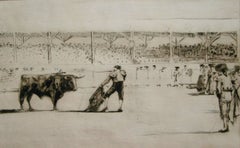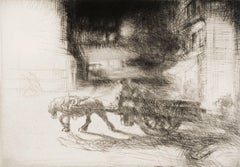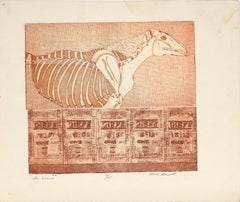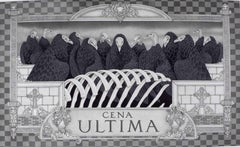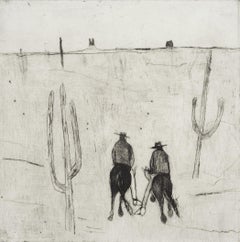Drypoint Animal Prints
1910s Modern Drypoint Animal Prints
Drypoint, Etching
1920s Modern Drypoint Animal Prints
Drypoint, Etching
1970s Modern Drypoint Animal Prints
Paper, Ink, Drypoint
1990s Contemporary Drypoint Animal Prints
Drypoint, Etching, Aquatint
2010s Contemporary Drypoint Animal Prints
Paper, Drypoint, Etching
2010s Contemporary Drypoint Animal Prints
Paper, Drypoint, Etching
1980s Contemporary Drypoint Animal Prints
Paper, Ink, Drypoint
2010s Contemporary Drypoint Animal Prints
Etching, Mixed Media, Paper, Drypoint
2010s Contemporary Drypoint Animal Prints
Drypoint
2010s Contemporary Drypoint Animal Prints
Drypoint
2010s Contemporary Drypoint Animal Prints
Drypoint
1980s Contemporary Drypoint Animal Prints
Paper, Ink, Drypoint
2010s Contemporary Drypoint Animal Prints
Drypoint
2010s Contemporary Drypoint Animal Prints
Drypoint
1930s Drypoint Animal Prints
Drypoint, Etching
1940s American Realist Drypoint Animal Prints
Drypoint
1920s American Impressionist Drypoint Animal Prints
Drypoint
1920s American Realist Drypoint Animal Prints
Drypoint
1940s American Realist Drypoint Animal Prints
Drypoint
2010s Abstract Drypoint Animal Prints
Drypoint, Acrylic
1930s Modern Drypoint Animal Prints
Drypoint, Aquatint, Etching
2010s Contemporary Drypoint Animal Prints
Paper, Drypoint, Etching
20th Century Modern Drypoint Animal Prints
Drypoint, Aquatint
1970s Abstract Expressionist Drypoint Animal Prints
Engraving, Drypoint, Etching, Aquatint, Mixed Media, Pencil, Graphite
20th Century Modern Drypoint Animal Prints
Drypoint, Aquatint
20th Century Modern Drypoint Animal Prints
Drypoint, Aquatint
20th Century Modern Drypoint Animal Prints
Drypoint, Aquatint
20th Century Modern Drypoint Animal Prints
Drypoint, Aquatint
20th Century Modern Drypoint Animal Prints
Drypoint, Aquatint
20th Century Modern Drypoint Animal Prints
Drypoint, Aquatint
20th Century Modern Drypoint Animal Prints
Drypoint, Aquatint
20th Century Modern Drypoint Animal Prints
Drypoint, Aquatint
20th Century Modern Drypoint Animal Prints
Drypoint, Aquatint
20th Century Modern Drypoint Animal Prints
Drypoint, Aquatint
20th Century Modern Drypoint Animal Prints
Drypoint, Aquatint
20th Century Modern Drypoint Animal Prints
Drypoint, Aquatint
20th Century Modern Drypoint Animal Prints
Drypoint, Aquatint
20th Century Modern Drypoint Animal Prints
Drypoint, Aquatint
20th Century Modern Drypoint Animal Prints
Drypoint, Aquatint
20th Century Modern Drypoint Animal Prints
Drypoint, Aquatint
20th Century Modern Drypoint Animal Prints
Drypoint, Aquatint
1970s Surrealist Drypoint Animal Prints
Paper, Drypoint, Etching
1970s Surrealist Drypoint Animal Prints
Drypoint, Paper, Aquatint
1970s Surrealist Drypoint Animal Prints
Drypoint, Paper, Aquatint
1970s Surrealist Drypoint Animal Prints
Drypoint, Paper, Aquatint
1970s Surrealist Drypoint Animal Prints
Drypoint, Paper, Aquatint
1970s Surrealist Drypoint Animal Prints
Drypoint, Paper, Aquatint
1970s Surrealist Drypoint Animal Prints
Drypoint, Paper, Aquatint
1970s Surrealist Drypoint Animal Prints
Drypoint, Paper, Aquatint
Late 20th Century Surrealist Drypoint Animal Prints
Drypoint, Paper
1970s Surrealist Drypoint Animal Prints
Drypoint, Paper, Aquatint
1970s Surrealist Drypoint Animal Prints
Drypoint, Aquatint, Paper
1970s Surrealist Drypoint Animal Prints
Drypoint, Aquatint, Paper
Late 20th Century Surrealist Drypoint Animal Prints
Drypoint, Paper
Late 20th Century Surrealist Drypoint Animal Prints
Drypoint, Paper
Late 20th Century Surrealist Drypoint Animal Prints
Drypoint, Paper
Late 20th Century Surrealist Drypoint Animal Prints
Paper, Drypoint
1970s Surrealist Drypoint Animal Prints
Drypoint, Etching, Lithograph
